Empowering women in construction


Look, it’s no secret that the construction industry is traditionally male dominated. While there’s been strides of change, a reduction of the gender pay gap from 16% to 7% (as per latest figures), there’s still a way to go. This International Women’s Day serves as a powerful reminder of the strides we’ve made towards gender equality and the work that still lies ahead. In the construction industry, historically dominated by men, the journey towards inclusivity and diversity is tough. At EstimateOne, we’re committed to not just discussing inclusion, but actively embodying it, as highlighted by Zaiga Finnis, our Chief Customer and Commercial Officer:
“In my journey navigating the construction industry from interior designer to my current role at E1, I’ve seen first-hand the importance of supportive workplace communities that empower women. Building networks, seeking mentors and career sponsors, and staying updated on industry activities are crucial for career progression.
It’s vital to offer professional development, mentoring, and opportunities to foster inclusivity for all. With 50% of our senior leadership team and executives being women, we’re not just talking about inclusion, we’re living it.”
Zaiga’s experience stresses the importance of creating environments where women can thrive. At EstimateOne, we understand that empowering women goes beyond hiring; it’s about nurturing their growth, ensuring they have access to the same opportunities as their male counterparts, and recognising their contributions to our industry’s innovation and success.
Let’s use this International Women’s Day to celebrate the achievements of women in construction while acknowledging the road ahead. Together, we can challenge stereotypes, fight bias, and broaden perceptions. Join us in building a construction industry where everyone, regardless of gender, can construct a successful and fulfilling career.
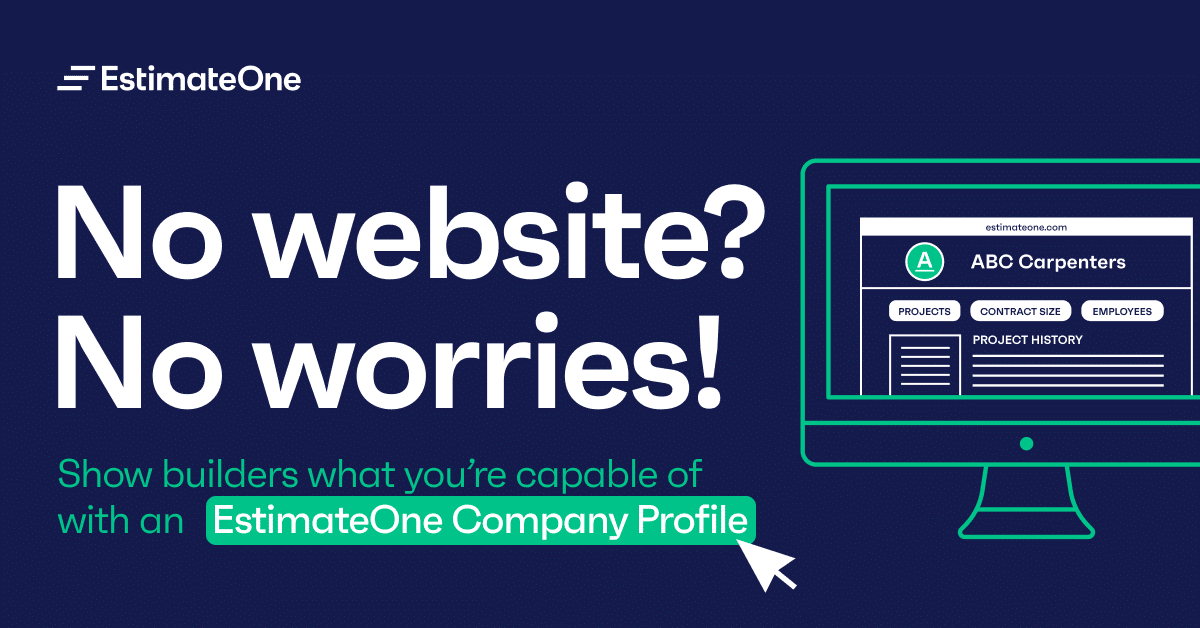
When it comes down to it, standing out in a crowded marketplace is the best way to give you the edge over your competitors.
Your Company Profile on EstimateOne is the first thing builders see when viewing your business. A well thought-out and impressive Company profile puts your business’s best foot forward. It gives you the opportunity to showcase your capabilities, experience, and trade directly to builders on the platform.
With EstimateOne, you can create a company profile tailored to showcase your trade and experience, so potential clients see exactly what you offer. Whether you are a carpenter, painter or any other highly skilled trade professional, putting together an impressive profile will help build trust and spark interest from builders.
So, how do you get started? Here are some tips for setting up your Company Profile on EstimateOne.
A strong brand identity is key to making a positive first impression.
> Include your company logo. This not only showcases your professionalism, but the visual branding will help builders remember who you are.
> Write an engaging About Us section. Here you can explain more about your business story, who’s behind it and what makes you unique. You can also use this section to tell them more about specific services that set you apart from competitors or any special technology or equipment that could be beneficial for their project needs. Being able to demonstrate professional qualifications or any awards won can also immensely improve your chances of securing projects – so this should absolutely be included in your profile.
Technical information adds another layer of assurance for prospective customers that they are contacting a competent and reliable business partner.
> Highlight the relevant trades you work across, as well as any categories that you may specialise in.
> Add your ABN so builders know you are a legitimate business.
> Setup your contract size parameters and workforce size. This helps builders know the scale of projects you are capable of working across.
> List your office locations so builders know you’re local.
Once set up, it’s important to keep your profile active and updated regularly. This can capture attention from new leads and remaining top-of-mind with existing ones when it comes time for them needing a Subbie again in the future.
Having accurate details can also open up more opportunities for work as builders will feel more confident if they are able to quickly gain an understanding of who they are potentially working with.

Don’t wait to bid on jobs. With an advanced profile you can be found by builders and list previous projects you’ve worked on.
A Project History allows you to establish credibility and trust with builders. Think of it as a brag sheet to demonstrate to builders your experience and why you’re the best fit for the job.
Your Project History gives builders a comprehensive overview of your project history, including:
> Project Name
> Category
> State
> Contract Value
> Builder Name
> Project Description
You can also include a description of the work where you can include additional information on your project achievements. This helps builders assess the relevance and suitability of your company during pre-qualification and better understand your capability.
You have a maximum of 20 projects to include, so make sure add the most recent and relevant projects here. If you have worked with large national companies before, it would be beneficial to prioritise these so you can give big clients confidence that you you can complete their project successfully and efficiently.
Adding a project history is simple. Simply search completed projects in EstimateOne’s database of past tenders you have worked on.
By listing your business in our Subbie Directory, builders can quickly and easily identify projects that are best matched to your trade and experience.
Builders in tender and awarded stages of a project will use the directory to search and view your Company Profile information.
> Receive invitations directly from builders searching for your trade.
> Build and maintain new builder relationships for ongoing work opportunities.
(Just a heads up, this is only available to customers in NSW and VIC and we will soon be rolling this out nationwide!)

With these tips, creating a winning Company Profile on EstimateOne should be quick and easy. Claim your Company Profile today.
And if there’s ever anything confusing or if they need help along the way–don’t worry! Our team at EstimateOne can help guide you through the process. Call us on 1300 705 035 today or email us at support@estimateone.com

When it comes to quoting jobs, although the price is important it only tells one part of the story. We want to help you stand out in front of builders on something other than price, by showing off your experience, suitability and qualifications, thereby improving your chances of winning the job. It’s feedback we often get from Subbies, so we’re excited to have launched Company Profiles within Estimate One.
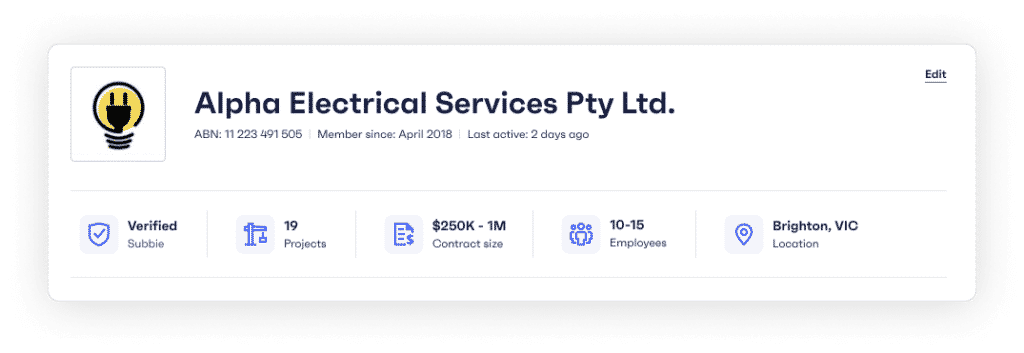
Your company profile will provide businesses with a snapshot of your business, things like size, location and a short bio. Think of it as a digital business card. It’s dynamic, up-to-date and will be shown to the builders when you request documentation and submit quotes.
While we’re excited about this first release, what we’re really looking forward to is what comes next. Over the next few months we’ll be adding new elements to your profile to really help you shine.
Here’s a preview of what’s to come:

Address book integration (coming soon)
When inviting subbies to tender on a project, builders tap into an address book they host on EstimateOne. However, until now this has been static and details can become out of date. Having a Subbie Company Profile on EstimateOne ensures builders all ways have access to the latest and greatest info of your business.

Project history
You will be able to showcase projects you are proud of and demonstrate your trade experience. Simply search completed projects in EstimateOne’s database of past tenders or upload your own using a template.
Region of operation
Operate in a regional area, cover specific regions within a state or have multiple operations all over the country? Soon you’ll be able to define what regions you operate in within your company profile. This will allow builders to search for required trades in specific locations and increase your chance of being invited to quote on the projects that suit your preference.
Certificates and licenses
Stop wasting time finding all of your trade licenses and certifications to send to Contract Admins at contract time. Uploading them into your Company Profile lets builders know that they are dealing with a fully qualified organisation at tender time.
Business verification status
If you want, you can apply to have your business verified by EstimateOne. This will signal to builders that you are a legitimate subcontractor operating on EstimateOne, with a profile that proves you meet a minimum standard of compliance. This creates an early sense of trust when developing a new subbie-builder relationship.
This is the first of many new features coming to the subbie platform in 2022 to help you win more work. Keep an eye on your inbox and in-app notifications to access these new features as soon as they’re ready.
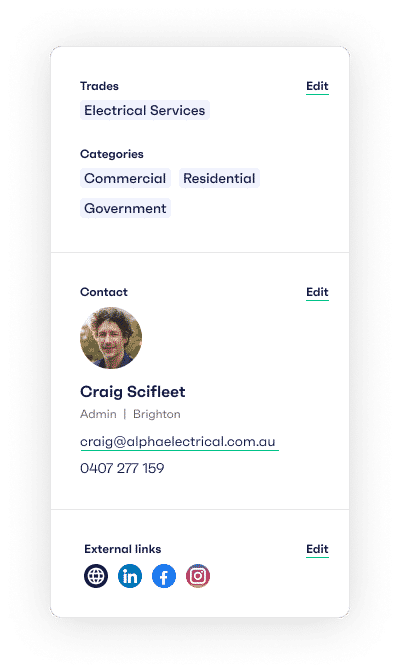
Already using EstimateOne? Update your profile today!

Introducing the Subbie Profile
When it comes to quoting jobs, although the price is important it only tells one part of the story. A piece of feedback we often hear from Subbies is that they’d like a way to stand out in front of builders on something other than price. A way to show off experience and qualifications.
That’s why we’re excited to announce the latest Subbie feature release, launching in a matter of weeks!

Your company profile provides builders with your current business information including contact information, trades, categories of work, size and office location. Think of it as a digital business card. It’s dynamic, up-to-date, and will be included in any quotes you create on EstimateOne.
While we’re excited about this first release, what we’re really looking forward to is what comes next. Over the next few months we’ll be adding new elements to your profile to really help you shine.
Here’s a preview of what’s to come:
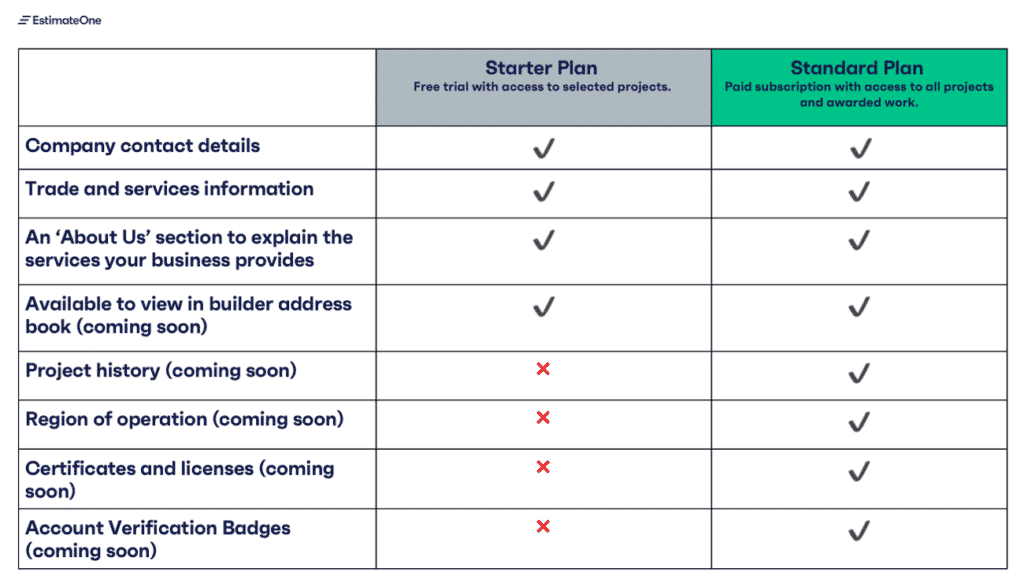
Address book integration
When inviting subbies to tender on a project, builders tap into an address book they host on EstimateOne. However, until now this has been static and details can become out of date. Having a Subbie Company Profile on EstimateOne ensures builders all ways have access to the latest and greatest info of your business.

Project history
Subbies on the Standard Plan will be able to showcase projects they are proud of and demonstrate your trade experience. Simply search completed projects in EstimateOne’s database of past tenders or upload your own using a template.
Region of operation
Operate in a regional area, cover specific regions within a state or have multiple operations all over the country? Soon you’ll be able to define what regions you operate in within your company profile. This will allow builders to search for required trades in specific locations and increase your chance of being invited to quote on the projects that suit your preference.
Certificates and licenses
Stop wasting time finding all of your trade licenses and certifications to send to Contract Admins at contract time. Uploading them into your Company Profile lets builders know that they are dealing with a fully qualified organisation at tender time.
Business verification status
Subbies on the Standard Plan can apply to have their business verified by EstimateOne. This will signal to builders that you are a legitimate subcontractor operating on EstimateOne, with a profile that proves you meet a minimum standard of compliance. This creates an early sense of trust when developing a new subbie-builder relationship.
This is the first of many new features coming to the subbie platform in 2022 to help you find and win work. Keen an eye on your inbox and in-app notifications to access these new features as soon as they’re ready.

Have ideas on what we should include in the Company Profile? Get in touch at support@estimateone.com – we’d love to hear from you!

As a subbie, we hope you’re aware of what you can and can’t write off with the tax man.
If you’re not, we’d recommend giving the ATO’s website on deductibles a quick look over to make sure you’re claiming everything you are entitled to
Because you’ve clicked through to this article, it should also come as no surprise that you can claim an EstimateOne subscription as a business expense. (that’s the win-win part).
And unless you’re using EstimateOne for personal reasons – which hey, if you are we won’t judge – you’ll be able to claim the entirety of your subscription’s cost.
If you’re keen to upgrade your EstimateOne you can do so here.
To make sure you’re doing everything above board all we’d recommend is –
Hang onto those receipts… all your receipts are located in your EstimateOne account for download at any time.
And really that’s it… It’s not like the software costs hundreds of thousands – so claiming it on tax is pretty straight forward.
Win more work, pay less tax – sounds pretty good to us.
* This should probably go without saying, but we’re not a tax accounting firm, for the most robust advice we’d recommend having a chat to a qualified accountant.

It’s a pretty popular choice, particularly as construction is often used as a lever to boost the economy.
Most of the time it’s head contractors who take on the big government commercial construction projects. Through the tender process they’ll engage with subbies and suppliers to help get an idea of how much it’s all going to cost.
Usually through the construction tender process, you, as a subbie, may be required to submit a construction quote to the Head Contractor. However, you can still get on the government’s radar as a subbie directly.
Government commercial construction jobs can be a challenge to win, but once you’ve got the experience and foot in the door (formally through their processes too) you’ll be loving your job even more!
We’ll take you through some of the state level registers and the federal government to help you get that foot in the door.
First cab off the rank is the Australian suppliers register. This register promotes different products and services to buyers from overseas through the Austrade website.
Applying for the Austrade register itself is relatively straight forward for the first touch point.
The federal government’s criteria is quite specific. Before you apply, ask yourself the below.
If you think you tick all of these boxes and are confident, we recommend applying to the Australian Suppliers Directory.
Once you’ve applied, your application will be reviewed and someone will likely be in touch to gather more information to help them make a decision.
The Victorian Government has a Construction Supplier Register for commercial construction projects. The Constructions Supplier Register is a pre-qualification scheme, open to anyone who offers construction work and/or services. If you want government jobs, you need to be on this register!
Each supplier on the register has been classified as having the necessary skills and expertise, as well as financial capabilities and management systems needed to be involved in a Victorian Government construction project.
In Victoria, there are two main categories:
There is also now a third category to allow smaller businesses to get in the door. This category is for low value works of under $500,000 including GST.
The application process can be lengthy, but luckily the Victorian Government has given you pretty much everything you could possibly need to know before applying, including things like eligibility criteria.
You can check out the pre-application process here.
The Queensland Government has a few different methods of procurement.
They use several methods such as:
We won’t go through all of these, but you can check them out on the Business Queensland website.
It’s a little more difficult to track down the exact information you want on the Queensland Government website (it’s the government though, so are we surprised?). Your first bet is to check out the supply to Queensland Government page.
Usually there will be some form of tender process to complete to get the bigger jobs. You can also check out the supplying for buying categories and make sure you fulfil all the ethical requirements for supplying to the government before you take any further steps.
Once you’ve got all the information you need through exploration of their site, we recommend applying to the Queensland Government Supplier list.
In NSW, their process is a little more laid out in terms of what they expect.
The NSW Government have five procurement objectives:
These objectives allow a diverse range of suppliers to get in front of the government regardless of their size.
There are also particular obligations and responsibilities that you need to meet to become a supplier (as you would expect).
The NSW Government purchases a range of contracts and schemes either as a whole-of-government or agency-specific.
They also look at supporting small to medium businesses, including regional businesses. There’s also a focus on buying from Aboriginal business and Australian disability enterprises as well to ensure equal opportunity.
Before you sign up, it’s worth checking out the information the NSW Government has on supplying to government.
To get on the supplier list, you need to sign up here. Once you’re on the supplier list, anyone will be able to search you on the supplier list, which is accessible to the public as well.
The Western Australia Government makes purchases a few different ways:
The method is usually selected by the particular agency looking to source the supplier. There are a few different rules to each method of purchase, for example, verbal quotes can be requested for works up to $50,000 including GST.
Due to the high Aboriginal and Indignous population in WA, the Western Australia Government
has a big focus on working with Aboriginal business, as well as businesses who employ Aboriginal and Indigenous workers.
Businesses can supply either goods and services, community services and works-related services to the Western Australia Government.
The Western Australia Government has put a short, brief guide together for suppliers who wish to supply goods and services here.
The go-to point if you wish to get in front of them is to register your business as a supplier through Tenders WA. Tenders WA is used to source all suppliers for government works.
Occasionally they may use newspapers and websites, however your best bet is to get yourself onto Tenders WA.
Hopefully these insights and resources help you to figure out next steps. It can be a bit daunting navigating the government sites when it comes to procurement so have a dig and don’t hesitate to reach out to them when you have queries.
Don’t forget to check out our other articles as well. It can’t hurt to brush up on how to choose construction tenders and how to bid on commercial construction tenders either!

It’s fair to say that 2020 didn’t pan out as expected. At the start of the year, no one could predict the changes we would eventually make to the way we work, the way we socialise and essentially, the way we live.
Although a global pandemic threw the mother of all spanners in the works – as a whole, Australia and the Australian construction industry managed to steer a steady ship throughout the year.
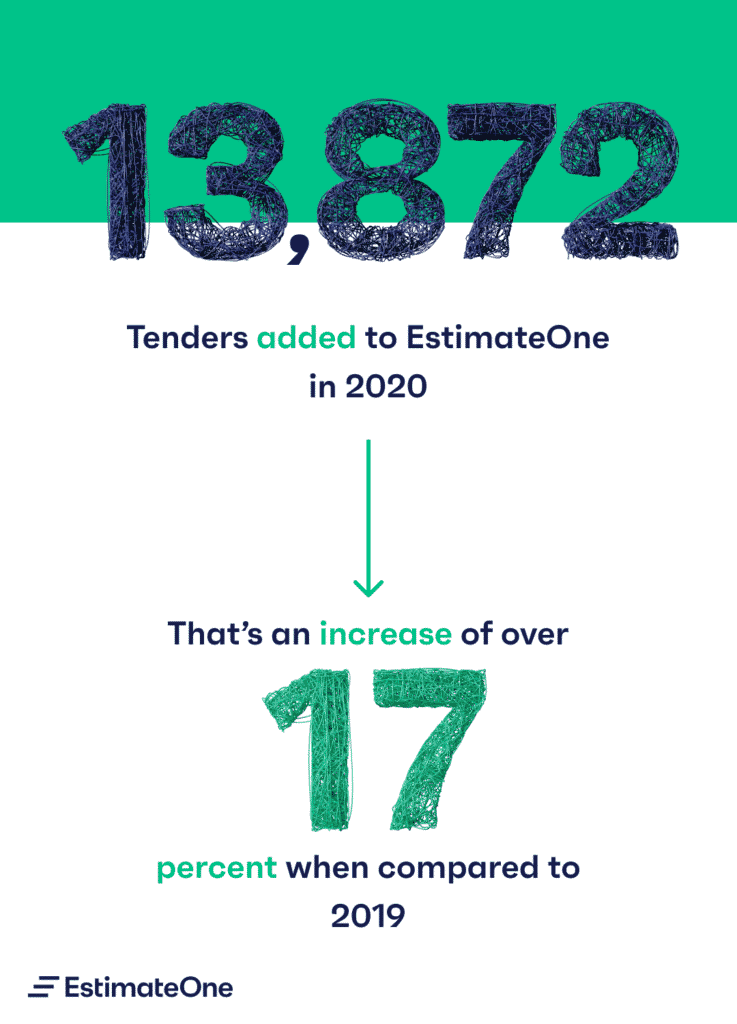
While it’s always great to see a lift in tender numbers, a survey we commissioned mid last year told us that the year wasn’t always smooth sailing.

As we can see in the graph above, tendering dipped and continued to stay low around March – June. However, in the back half of the year where tendering made a strong recovery.
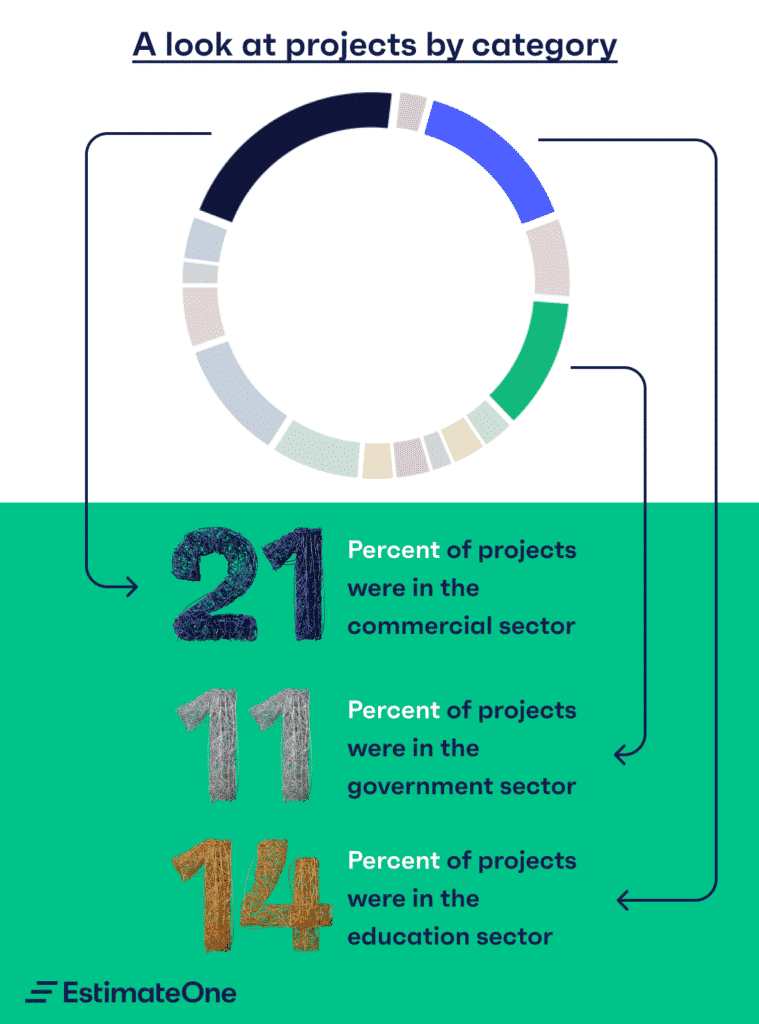
In 2020 we saw an increase in projects added to the noticeboard across all categories. Along with this increase in tendering, we also saw an increase in competitiveness. Compared to 2019, tender panels tended to have more builders.
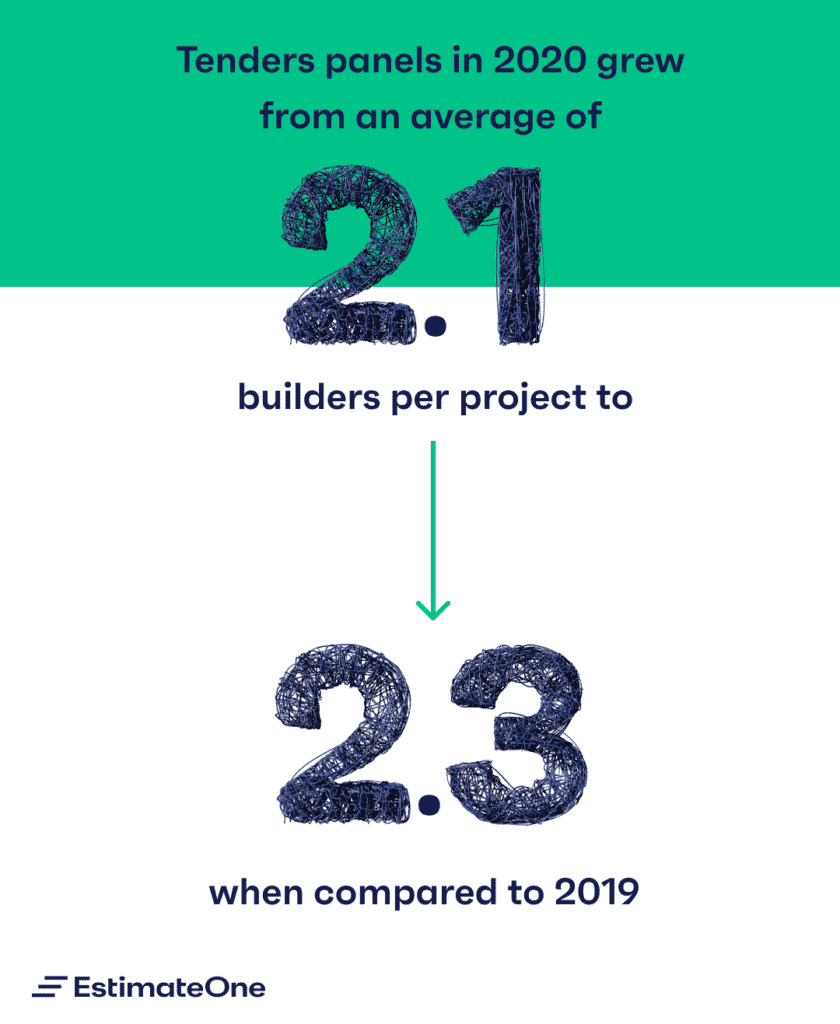
Anecdotally, we were hearing that market uncertainty was leading to increased competition. Builders were seen to have tendered on jobs that they wouldn’t have usually tendered on in order to sure up a pipeline of work.
If you’re not on already, we’d recommend creating a free EstimateOne account. It’s the best place to access and quote on upcoming construction projects in Australia.

Subcontractor tenders are relatively straight forward for the most part as it usually requires submitting a quote or estimate.
We’ve got a number of benefits for our subscribed members when it comes to finding tenders and builder details. EstimateOne is designed to help you out in finding your next construction tender.
We won’t get into the nitty gritty of what a tender is (because we’ve already done it here) because at this point you’re ready to submit your tender response, quote or estimate.
There are always head contractors looking for subcontractor quotes everyday and while you may not always get the job, getting in front of the head contractors more regularly and making a good impression is how you win in the end.
If you haven’t already used EstimateOne before, you’re in for a treat. We’ve made the tender filtering and organisation process so much easier for you.
We’ve got all subbies covered in every imaginable trade from carpentry, swimming pools, electrical, metalwork, asbestos removal, all the way to caulking and more. You name it, we’ve got you covered.
Work in a niche trade? We’ve got you sorted as well. Just type in your trade in the search bar and we’ll show you every project where it’s been mentioned within the documentation.
We’re here to give you the opportunity to hone in on your niche and sell yourself to the guys that matter (the head contractors with the big dollar jobs)!
So what are we looking at here you ask? Well, below is a snapshot of what your notice board looks like once you have a full membership with us. Looks good right?

Up top, you can click through the tabs to look at tenders, invitations and requests, quotes, watchlist, directory, team and of course your settings. Pretty intuitive once you’re in there.
Then, that wonderful list of jobs below is where you can see the tenders. As a member, you’ll have access to all open, awarded and closed tenders.
We’ve liaised with every possible person when it comes to tenders to really give you exactly what you need in one place.
Below you’ll see more of a narrowed filter option on your notice board.

Here, you can do everything from searching by budget, trade, distance (including from your office or simply state or national), category, when it was awarded and whether it has documents available (just hit more filters).
Once you have the list in front of you, you can also play around with the below toggles to get what you need.
Perhaps you want the jobs where quotes are due soon? In that instance, you would toggle the Quote Due heading to see which head contractors have their tender responses due the soonest and who would may be ready for your quote ASAP.

The interest filter is where the fun happens. If you feel like you’re overwhelmed with all the quotes and projects flying around, your life is about to get ten times easier.

When you are looking through tenders, simply tag the project as one of the interest levels from not interested to quoting and more, and you’ll then be able to filter these later on (thank us later when you’re rolling in jobs).
Think of it as your own digital book of jobs where all the paperwork, details and everything have been organised in one place for you.
Honestly, we could sit here all day and tell you the great features and access to builders we can provide to you, but we recommend you sign up for a free subbie account first to check it out for yourself.
As a subbie, you always need to think of your network with every interaction you have to find your next construction job. You’ll see once you are signed up that we do have a builder’s directory with all the details of most head contractors across Australia.
Even though we do have that for you to tap into when you need, nothing beats the personal relationships you build over time with head contractors.
You should always find your niche, that is, where you fit into the wider industry. What’s your specialty? What makes you better than the rest?
Then, your job is to sell that, and sell it hard. Your enthusiasm and strong knowledge of your specialty will impress the right builders and keep you in mind for future.
That doesn’t mean you shouldn’t keep in touch with them along the way. In this case it is both about what you know and who you know.
We recommend checking out our articles on our insights blog tips for quotes, tender processes and more to help you with your next job.

As a subbie, you’ll most likely be well versed in how to quote a construction job.
However, sometimes a much larger job will come along that you have to really put in the hard yards to win over the heart of the head contractor who is tendering for a job.
You probably have what a tender is down pat, so we’ve got some tips for putting together your best quote yet.
A construction quote is a formal document of pricing that a business needs to be paid in order to fulfil the job requirements.
In the construction industry, quotes and estimates are sometimes used interchangeably (also sometimes referred to as “costing” or “pricing” a construction job).
When it comes to a quote versus an estimate, an estimate differs only slightly from this in that it is more of an idea of how much the materials, labour and other parts may cost.
Sometimes there might be some variables that may make it difficult for a business to give an accurate quote, therefore an estimate is your best best until you get clarification.
At all different stages of the construction tenders process, you may be required to provide a quote, estimate or costing.
Construction quotes can be pretty straight forward if you know how to write a quote.
There’s a few key things you want to make sure you include so that it’s the most accurate representation of what you have to offer.
Considering the quote might be quite long, it’s always worth making it extra clear what your overall figure is. We’re talking big, bold text. Make sure it’s clear what the tax excluded and tax included pricing is.
Don’t make the head contractor suffer by reading all the small font line items.
You’ll need to include the obvious details of both parties involved,
Here’s where the hard work goes. You’ll need to show the head contractor what is and isn’t included. This is applicable to both the labour and materials.
Inclusions can sometimes include:
When it comes to exclusions, you want to be super clear as well. This can vary but may include things like:
There’s a few tricks of the trade when quoting out materials. Sometimes a head contractor will name a specific brand in the documentation that you’ll need to quote installation and labour against. Other times, you may have to provide options.
The best way you can do this is by clearly listing each material requirement and installation as separate line items (the contractor will love you for this).
When you are listing out materials, it’s important to be as clear as possible, particularly when it comes to allowances.
Sometimes the head contractor or other people working on the project might change a design so you’ll need to accommodate any changes and be flexible with your quoting.
Head contractors like to see that you’ve clearly allowed for variation in product or other elements. You should do this by including measurements and clear descriptions.
A good example when it comes to flooring would be:
Or for carpentry:
It’s all about clarifying the small parts of the job so that the head contractor has everything up front, clear and ready to go should you be selected.
Head contractors are always looking for large tender jobs. Depending on your past experience and relationships you may get approached to quote a construction job for a subcontractor tender.
Otherwise, you may have to reach out to the head contractor, sell yourself and provide a great quote for your trade part of the tender.
After a contract is awarded, head contractors will also typically circle back to you to try negotiate the price down further (or as they like to call it, “sharpen your pencils”). This is where you’ll need to remain competitive with your pricing as well and will likely keep you in their good books for future. Be smart with your quoting throughout the process!
If you’re looking for more tips on subcontractor tenders, responses and general industry knowledge, don’t forget to check out our other articles on our Insights blog.

To bid for construction work, subcontractors must submit a tender to be considered for the job.
When it comes to bidding for construction tenders, there’s so many things to consider when completing a tender response.
Your tender response will always need to show your unique value proposition and tick all the boxes the contractor has set. Think of tender responses like exams. You need to be prepared, answer concisely and persuasively.
In the meantime, we’ve put together a more specific guide on how to bid for construction project tenders.
Before you can even start thinking about how to write a tender response, you need a tender to bid for.
Tenders won’t always fall into your lap. It’s important to always network, network, network (we cover this in our article How to find your next construction job as a subcontractor).
The best way to get invitations to tender or get a whiff of any work that’s out there is to keep these networks alive!
Some builders we have on EstimateOne maintain an address book of subbies (who are, of course, also on EstimateOne). If you request documents from a head contractor and introduce yourself, you’re likely to be added to that address book.
When it comes to the tender, typically a contractor will send out invitations to tender which will likely include the:
Depending on the tender, there is usually a lot more information to help you out. Head contractors will usually package this out to specific trades so you receive the relevant information you need to include in your proposal.
This is where you draw all the information you need in order to make a bid for a construction project.
Writing a quote isn’t a simple task. Some businesses get professional bid writers to help them out. We’re here to give you confidence in writing it yourself with tips for your construction bid.
Things you could include in your response:
Sometimes it’s even worth putting in information about the staff who you would select to work on the project. Some people like to know who specifically will be working and their experience.
We can’t stress enough how important it is to answer the questions or address any specific requests made by the contractor. If you’re unsure of anything, you can always ask questions for clarification.
After you’ve completed your response you should review, review, review.
Once you’re completely happy with your response, it’s time to submit!
For more info check out our article on How to prepare a quote for construction work.
Once you’ve reached the submission stage it’s important to call out what you have and haven’t quoted. This will ensure that everything is super clear with what you will and won’t be doing.
The actual submission is pretty quick (in terms of your input). Once you’ve submitted your proposal by the deadline, contractors will compile all responses and start reviewing them.
So long as you’ve met their requirements and provided an immaculate document, you’ll be in with a chance.
A lot of turning points for contractors are the pricing structures, so without putting yourself in a bad position, do your absolute best on pricing. This will give you a competitive advantage over others.
It’s always worth chasing up the head contractor as well to show your interest (exactly like a job interview).
As the contractor reviews submissions they may conduct interviews during this period to go through any specific details of a bid they want to expand on.
Contractors will work off their own timelines so if you have the hunger for more work, use this time to search for other tenders and get cracking on some other responses to maximise your opportunities.
Check out our subbie section for some relevant tenders out there at the moment for your trade.
Once the contractor has made the final decision on which tender bid they’d like to select, this is where you come in and start negotiations.
Obviously there’s a huge amount of moving parts in a project so pending on changes or any specifics, there’s still opportunity for you to negotiate different elements of your bid, without veering too far from your proposal (you know, the one that won you the job).
Once you nut out all this information with the contractor you will reach the agreement phase.
Remember…
In case that was a lot of information to absorb, we’ll recap for you.
For your tender responses, always consider the below points:
The design and aesthetic of the response